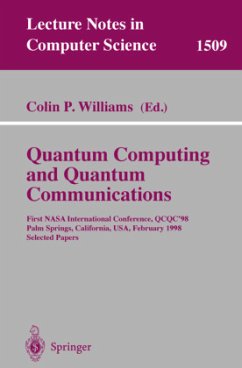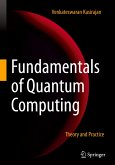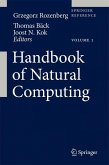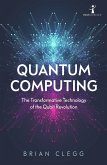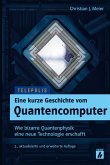This book contains selected papers presented at the First NASA International Conference on Quantum Computing and Quantum Communications, QCQC'98, held in Palm Springs, California, USA in February 1998.As the record of the first large-scale meeting entirely devoted to quantum computing and communications, this book is a unique survey of the state-of-the-art in the area. The 43 carefully reviewed papers are organized in topical sections on entanglement and quantum algorithms, quantum cryptography, quantum copying and quantum information theory, quantum error correction and fault-tolerant quantum computing, and embodiments of quantum computers.
Over the past half century computers have gone from being the room-sized servants of a privileged few to the totable companions of business travellers, schoolchildren,andjust aboutanyonewho canpoint andclick a mouse. Inpart, this transformation was made possible by the dramatic miniaturization in the basic components of a computer. This trend was quantied in 1964 by Gordon Moore, one of the founders of Intel, who noticed that the amount of information that could be stored on a given amount of silicon doubled roughly every 18 months. The doubling trend continues to this day and, by crude extrapolation, predicts that the computers of 2020 might be approaching the one-atom-per-bit level. Physical systems such as atoms, however, behave in ways that are very d- ferent from everyday objects. In fact they are governed by the laws of quantum mechanics rather than classical mechanics. In the early 1980 s some foresighted physicists,suchesCharlesBennett(ourconferenceChairperson),RolfLandauer, Paul Benio, David Deutsch, and Richard Feynman, began to question what it would mean for a computer to operate at the one-atom-per-bit scale. The - ementary operations of such a computer would need to be described in terms of quantum mechanics. Recently, physicists and computer scientists have come to appreciate that certain quantum e ects, in particular superposition, int- ference, entanglement, non-locality, indeterminism, and non-clonability, allow entirely new kinds of tasks to be performed.
Over the past half century computers have gone from being the room-sized servants of a privileged few to the totable companions of business travellers, schoolchildren,andjust aboutanyonewho canpoint andclick a mouse. Inpart, this transformation was made possible by the dramatic miniaturization in the basic components of a computer. This trend was quantied in 1964 by Gordon Moore, one of the founders of Intel, who noticed that the amount of information that could be stored on a given amount of silicon doubled roughly every 18 months. The doubling trend continues to this day and, by crude extrapolation, predicts that the computers of 2020 might be approaching the one-atom-per-bit level. Physical systems such as atoms, however, behave in ways that are very d- ferent from everyday objects. In fact they are governed by the laws of quantum mechanics rather than classical mechanics. In the early 1980 s some foresighted physicists,suchesCharlesBennett(ourconferenceChairperson),RolfLandauer, Paul Benio, David Deutsch, and Richard Feynman, began to question what it would mean for a computer to operate at the one-atom-per-bit scale. The - ementary operations of such a computer would need to be described in terms of quantum mechanics. Recently, physicists and computer scientists have come to appreciate that certain quantum e ects, in particular superposition, int- ference, entanglement, non-locality, indeterminism, and non-clonability, allow entirely new kinds of tasks to be performed.

